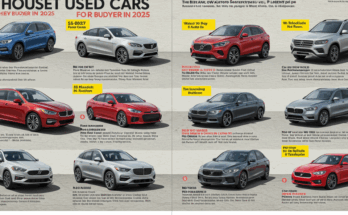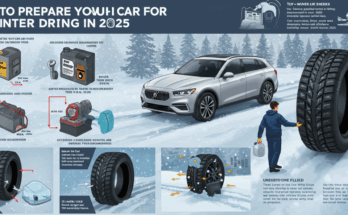Purchasing a used car in 2025 can be an exciting yet daunting task, especially with the rapid advancements in automotive technology and the ever-present risk of ending up with a “lemon”—a vehicle plagued with persistent issues that make ownership a costly nightmare. A lemon can drain your wallet and patience, but with the right knowledge, you can navigate the used car market with confidence. This comprehensive guide will walk you through the essential steps to spot a lemon, from pre-purchase research to post-test-drive inspections, ensuring you drive away with a reliable vehicle that meets your needs.
Why Buying a Used Car Requires Vigilance
The used car market in 2025 is more complex than ever, with a mix of traditional gas-powered vehicles, hybrids, and electric cars flooding dealerships and private listings. While many used cars offer excellent value, some hide costly problems like faulty batteries, worn-out suspensions, or tampered odometers. A lemon isn’t just a car with minor quirks; it’s a vehicle with significant, often hidden, defects that affect its safety, reliability, or value. By staying proactive and thorough, you can avoid the financial and emotional stress of a bad purchase.
Researching the Car’s History
Check the Vehicle History Report
Before you even set foot on a lot, arm yourself with information about the car’s past. Services like Carfax or AutoCheck provide detailed vehicle history reports using the car’s Vehicle Identification Number (VIN). These reports reveal critical details such as past accidents, title issues, odometer rollbacks, and service records. In 2025, many platforms integrate AI-driven analytics to flag potential red flags, such as frequent ownership changes or flood damage. Always verify the VIN on the car matches the report to avoid scams involving VIN cloning.

Investigate Recalls and Reliability Ratings
Modern cars, especially those with advanced tech like autonomous driving features or electric powertrains, may have recalls for software glitches or hardware failures. Check the National Highway Traffic Safety Administration (NHTSA) database or manufacturer websites for open recalls. Additionally, consult reliability ratings from sources like Consumer Reports or J.D. Power to understand the model’s track record. For instance, some 2023 electric models have faced battery degradation issues, which could signal long-term problems.
Inspecting the Car in Person
Exterior Walkaround: Look for Red Flags
A thorough visual inspection can reveal signs of a lemon. Start with the car’s exterior, checking for mismatched paint, uneven panel gaps, or signs of rust, which could indicate poor repairs or water damage. In 2025, many used cars may have advanced sensors for parking or lane-keeping; ensure these are intact and not misaligned, as repairs can be costly. Use a flashlight to inspect under the wheel wells for hidden rust or shoddy patch jobs.
Interior Check: Comfort Meets Functionality
Inside the cabin, look beyond surface-level cleanliness. Test all electronics, including infotainment systems, climate controls, and advanced features like heads-up displays. Worn seats, cracked dashboards, or a musty odor could point to neglect or water damage. For electric vehicles, check the condition of the touchscreen and battery management system displays, as these are critical to the car’s operation and expensive to replace.
Under the Hood: Mechanical Health
Pop the hood and look for signs of poor maintenance, such as low fluid levels, corroded battery terminals, or frayed belts. For electric cars, inspect the battery cooling system and charging port for wear. If you’re not mechanically inclined, bring a trusted mechanic to spot issues like oil leaks or worn components. In 2025, hybrid and electric vehicles require special attention to their high-voltage systems, which can be costly to repair if damaged.
The Test Drive: Putting the Car to the Test
Listen for Unusual Noises
During the test drive, pay attention to how the car feels and sounds. Strange noises like grinding, clunking, or whining could indicate issues with the transmission, suspension, or electric motor. For gas-powered cars, listen for engine knocks; for electric vehicles, note any irregular humming from the battery or motor. Test the car on varied roads—highways, city streets, and bumpy paths—to assess its performance under different conditions.
Evaluate Performance and Handling
A lemon often reveals itself through poor performance. Check for sluggish acceleration, delayed gear shifts, or uneven braking. For electric cars, test the regenerative braking system and ensure the range matches the manufacturer’s claims. Advanced driver-assistance systems (ADAS) should function smoothly; any glitches, like lane departure warnings triggering incorrectly, could signal expensive sensor or software issues.
Test All Features
Don’t skip testing every feature, from power windows to adaptive cruise control. In 2025, many used cars come equipped with semi-autonomous features or over-the-air update capabilities. Ensure these systems are operational, as software-related repairs can be pricey. For instance, a malfunctioning lidar sensor could cost thousands to replace, turning a seemingly good deal into a financial burden.
Verifying Documentation and Ownership
Title and Registration
A clean title is non-negotiable. Avoid cars with salvage, rebuilt, or flood titles, as these often indicate severe past damage. In 2025, digital titles are becoming more common, so verify the title’s authenticity through state DMV portals or blockchain-based title services. Ensure the seller’s name matches the title to avoid scams involving stolen or misrepresented vehicles.
Service Records and Maintenance History
Request detailed service records to confirm the car has been well-maintained. Regular oil changes, tire rotations, and software updates (for newer models) are signs of a cared-for vehicle. Be wary of cars with gaps in maintenance history, as this could indicate neglect or hidden repairs. For electric vehicles, check for battery health certificates, which detail the battery’s capacity and degradation.
Getting a Professional Inspection
Even if the car seems perfect, a professional inspection is a must. A qualified mechanic can uncover issues that aren’t visible to the untrained eye, such as frame damage or failing hybrid systems. In 2025, many shops offer specialized



